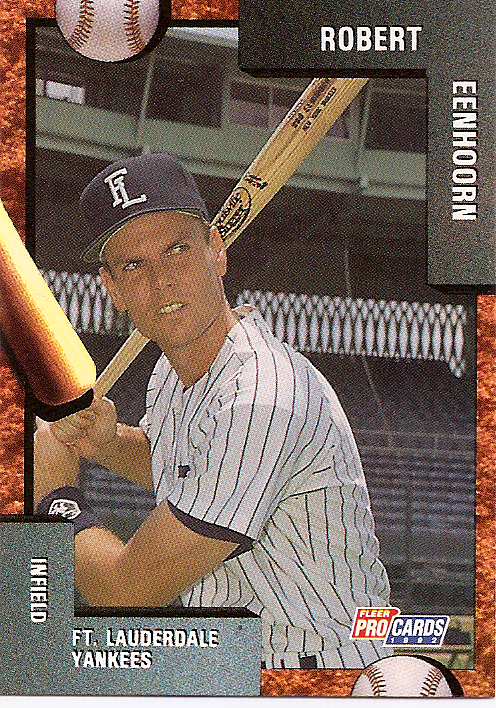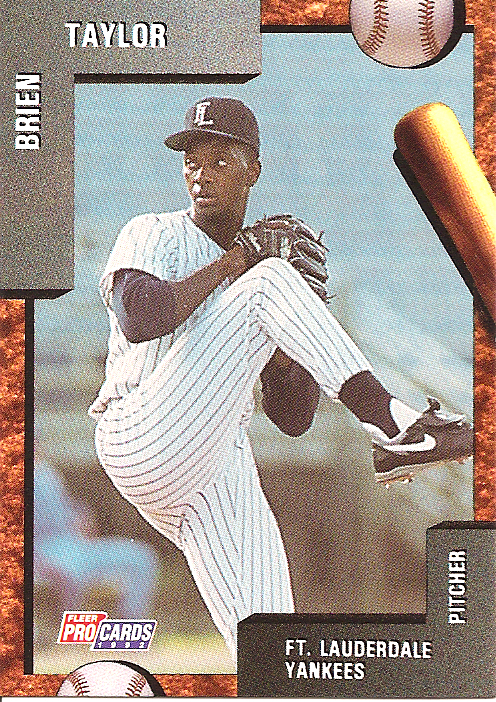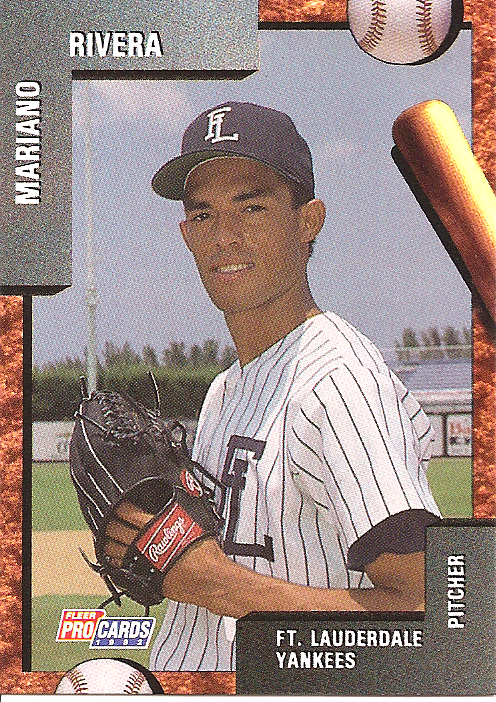Tagged: Brien Taylor
Banquo’s Closer
If you can look into the seeds of time,
And say which grain will grow and which will not,
Speak then to me, who neither beg nor fear
Your favors nor your hate.
I’ve always liked that snippet from Banquo’s second speech in Act 1, Scene 3, of Shakespeare’s Macbeth. But as fans have gotten more and more aware of the minor leagues and player development, it’s become more and more applicable to baseball.
“Which grain will grow and which will not…”
Hmmm.
Here are some images from the 1992 Fleer ProCards set of the Fort Lauderdale Yankees of the Florida State League. 20 seasons have come and gone since these kids were the future, and there were more opinions about them than each had seasons under his belt.
Do you remember this guy? Second-round pick in the 1990 draft, gaunt, rangy at 6’3″, 170, with the exotic birthplace of Rotterdam, Holland. The Yankees’ shortstop of the future (as viewed from 1992)…Robert Eenhoorn? It is literally true that he was a Yankee shortstop of the future. In fact, he was the shortstop on May 28, 1995, as the Yankees beat the A’s 4-1 in Oakland. Eenhoorn went 0-for-4, lowering his season performance to 0-for-7. The next game, in Seattle, the Yankees tried another young shortstop to fill in for the injured Tony Fernandez. Jeter somebody.
It is literally true that he was a Yankee shortstop of the future. In fact, he was the shortstop on May 28, 1995, as the Yankees beat the A’s 4-1 in Oakland. Eenhoorn went 0-for-4, lowering his season performance to 0-for-7. The next game, in Seattle, the Yankees tried another young shortstop to fill in for the injured Tony Fernandez. Jeter somebody.
Remember this next guy?
 I was at the Expansion Draft, the November after this card was made. The Yankees had just lost him to Florida, and I stepped into the hotel elevator to find General Manager Stick Michael, who looked like he’d just given blood – or was expecting that George Steinbrenner would make sure it was taken from it. He lasted longer than Eenhoorn (he did 202 homers and was on a World’s Championship team in Chicago) but given the baggage he seemed to proudly carry around (he was just arrested on family violence charges last week) it seems Michael’s anxieties were unfounded.
I was at the Expansion Draft, the November after this card was made. The Yankees had just lost him to Florida, and I stepped into the hotel elevator to find General Manager Stick Michael, who looked like he’d just given blood – or was expecting that George Steinbrenner would make sure it was taken from it. He lasted longer than Eenhoorn (he did 202 homers and was on a World’s Championship team in Chicago) but given the baggage he seemed to proudly carry around (he was just arrested on family violence charges last week) it seems Michael’s anxieties were unfounded.
Everett and Eenhoorn were the Yanks’ top two picks in 1990, but this next guy was the star of stars in their system as of 1992 – the first overall pick in the 1991 draft. If you bought this set in 1992, you bought it to get this card:
What is sadder than this?
Brien Taylor was the real deal. I saw him pitch at New Britain, Connecticut. Not only have I never seen anybody throw harder, I’ve never seen anybody throw as effortlessly. His 100-MPH pitches seemed to be thrown about 5% harder than his warm-ups. You couldn’t see any of them from the stands. And then there was a brawl in a bar, and his brother was in trouble, and he went in to help him, and they tore his pitching arm to shreds.
And so the star-crossed 1992 Fort Lauderdale Yankees would mostly be a tale of woe (there’s also a card of Mike Figga – he’d hit a major league home run – and of Domingo Jean – he’d win a major league game). But, if you can look into the seeds of time, and say which grain will grow and which will not, speak to me then.
There was also this skinny pitcher – he made Eenhoorn look robust – who’d struggled in Greensboro the year before (3-4, 5.45, 52 strikeouts to 40 walks) and he’s about to hit a milestone in a career that, frankly, dwarfed everybody else who was playing in the minor leagues when this card was made (and nearly everyone who was playing in the majors).
Strasburg On Cardboard
With the scouting observation that the most impressive part of Stephen Strasburg’s night was his willingness to work quickly, to maintain ownership of the pace and momentum of the game, a little sneak preview of a much more “official” welcome to the big leagues.

